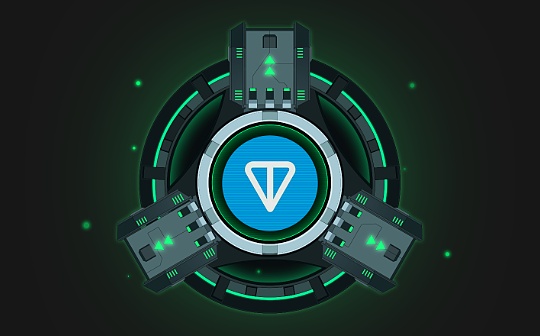
Source: Ryze Labs
1. Summary
The Open Network (TON) combines a layer of blockchain and a series of network protocols to form a decentralized platform similar to the Internet.Originally developed by Nikola Durov and promoted by the open source developer community, TON supports a variety of applications, including digital finance and decentralized storage.Its architecture adopts main chains and multiple work chains, enhances scalability and supports large-scale transactions and complex operations on the network.
TON’s development includes the Fragment platform, a decentralized market that has processed over $350 million in transactions, demonstrating the functionality and economic capabilities of the network.The integration with Telegram has facilitated new approaches to content monetization and user interaction, leveraging the widespread use of the platform.Recognition in the UAE and cooperation with major technology companies further expands TON’s global reach.
With the continuous development of TON, its role in promoting the transition of users to a decentralized network is becoming increasingly important.The ability of the TON network to handle a large number of transactions and support multiple applications gives it the potential to take the lead in blockchain innovation.Through ongoing strategic initiatives and growing adoption rates, TON aims to improve the efficiency and security of global digital transactions and contribute to the widespread use of blockchain technology.
2. Introduction
The Open Network (TON) is a decentralized computer network composed of a layer of blockchain (TON blockchain) and a series of network protocols (TON networks). These protocols support blockchain and can also be used as independent.Centralized network.It was originally developed by Nikola Durov, who co-founded Telegram in 2013 with his brother Pavel Durov.
The History of Telegram and TON
The Durov brothers founded Telegram in 2013 with the mission of “providing a secure communication method that is accessible worldwide.”Prior to Telegram, they were widely catching attention for founding VKontakte (VK), a Russian social media platform similar to Facebook.Pavel Durov, CEO of VK, was forced to leave in 2014 after investors claimed to be under pressure from the Russian government to provide user data and censor political content.The two brothers then left Russia to focus on developing Telegram, emphasizing user privacy and security.
Due to its advantages in speed and security, Telegram has rapidly become popular, and by March 2018, its monthly active users have exceeded 200 million.Prior to this, Telegram was funded primarily by Pavel through his Digital Fortress Fund.In order to raise external capital while maintaining the independence of the platform and protecting against external influences, the Durov brothers explored a variety of financing methods.In 2018, they launched Telegram The Open Network (TON), which aims to create a decentralized blockchain platform and launch its cryptocurrency Gram.TON’s initial token offering (ICO) raised $1.7 billion from private investors.However, the U.S. Securities and Exchange Commission (SEC) stepped in in October 2019 to sue Telegram for unregistered securities offerings.The long legal battle since then led Telegram to abandon the TON project in May 2020 and agreed to return $1.2 billion to investors and pay a $18.5 million fine.
However, this does not mark the end of TON.The code is separated from Telegram and open source, and the remaining testnet tokens are sent to smart contracts, allowing anyone to participate in future mining.A small group of open source developers, led by Anatoly Makosov and Kiril Yemeliyanenko, resumed the development of the project.The project was renamed to Toncoin, which eventually evolved into TON and received full support from Pavel Durov.
3. Components of TON
The Open Network is composed of network and storage components, and itself is a powerful decentralized network and web technology stack.The Open Network includes the following core components:
-
TON Blockchain: A blockchain blockchain – including main chain, work chain, shard chain and vertical blockchain.
-
TON Network: P2P network used to communicate/access with the network.
-
TON Agent: A network proxy/anonymity layer similar to TOR/I2P, used to hide the identity and IP address of the node.
-
TON DNS: Map human-readable domain names to accounts, smart contracts, services and network nodes through smart contracts.
Used to register and manage .ton domain names.
-
TON Sites: Allows users to establish a decentralized website, which can be accessed through example.ton, and is compatible with TON DNS domain name lookup.
Similar to hosting an NGINX web server on an AWS instance.
-
TON WWW: Protocol, allowing users to access TON Sites through .ton domain names in their browser.
-
TON Storage: Decentralized file storage and sharing using torrent technology through the TON network.
-
TON DHT: A distributed hash table – a decentralized data structure used to store key-value pairs. Each node manages a part of the overall data, supporting efficient and elastic search and retrieval.
A service locator for TON Storage “torrent tracker”, a TON proxy “input tunnel locator” and a TON service.
-
TON Services: A service platform that supports interactions similar to browsers or smartphone applications via the network and proxy access.
It can be on-chain, off-chain or mixed, used by human users or other applications/bots.
Includes the service registry and the nodes that run them.
-
TON Payments: A network of micro-payment channels for rapid off-chain value transfer, similar to the Bitcoin Lightning Network.
Here is a simplified overview of how they come together from a user’s perspective.
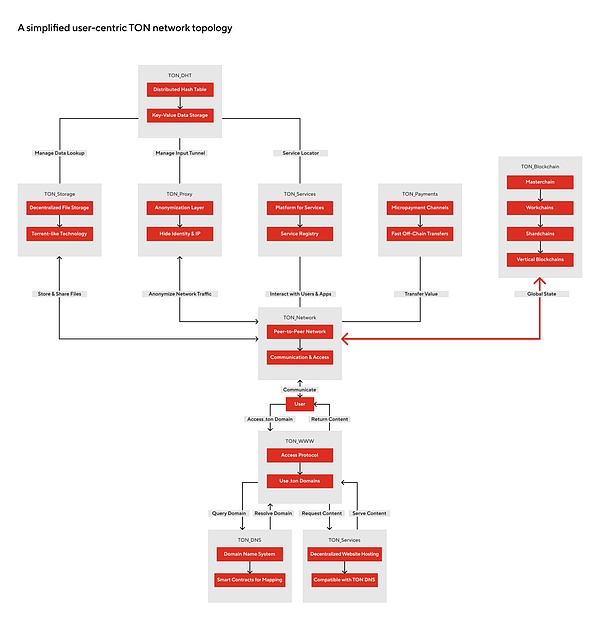
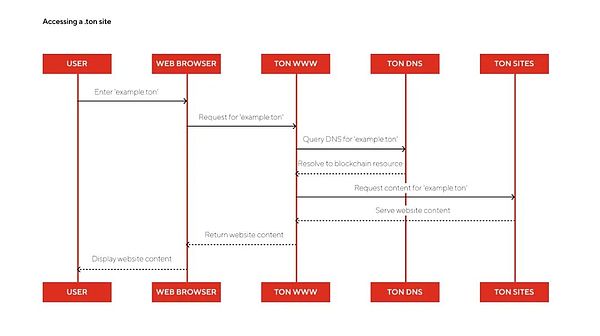
In short, in addition to its blockchain core, The Open Network also has a comprehensive set of technologies including a TOR-like network stack, decentralized and censor-resistant DNS, decentralized storage, proxy for anonymous communications,Integrated payment, etc.As TON evolves, it may create a fully decentralized network ecosystem where websites will be censor-resistant to all aspects of HTML code to hosting and delivery infrastructure, including servers and proxy.Additionally, with TON services, TON payments and Telegram applets, we look forward to seeing exciting new consumer applications and business models that are only possible on TON.
4. Technical architecture
The Open Network’s technology architecture leverages a multi-blockchain framework designed to enhance scalability, ensure strong security, and promote seamless interoperability.This multi-layer structure allows TON to efficiently manage large amounts of transactions and interactions.
Multi-blockchain design
The architecture of TON is built around a central main chain and multiple work chains, each work chain can be further subdivided into shard chains.This hierarchy enables TON to scale and manage different types and quantities of transactions in the network.
-
Main chain: At the top of the hierarchy, the main chain plays a key role in maintaining the overall integrity and continuity of the TON network.It acts as a primary ledger, documenting and validating significant network changes, coordinating various work chains, and ensuring global consensus is maintained.The main chain is responsible for key functions such as transaction finality and checkpointing across work chains and shard chains, and serves as the final arbitrator in the network multi-chain architecture.
-
Work chain: Independent blockchain, operates in parallel under the supervision of the main chain.Each work chain is designed to meet specific needs or industries, such as different token economies, decentralized applications (dApps), or compliance requirements, allowing customization and flexibility within the network.The work chain can have its own transaction format, consensus protocol, and even rules of its virtual machine, and developers can adjust functions based on specific use cases.
-
Sharding chain: To further enhance scalability, each working chain can be divided into multiple shard chains.This division is designed to allocate transaction load more efficiently, allocating a portion of the overall transaction to each shard chain.By processing transactions in parallel on multiple shard chains, TON has greatly improved its transaction processing capabilities.The shard chain runs according to the rules of the working chain to which it belongs, but mainly focuses on expanding transaction throughput.They synchronize and verify transactions with the help of the main chain, which summarizes and finalizes transactions across the entire network.
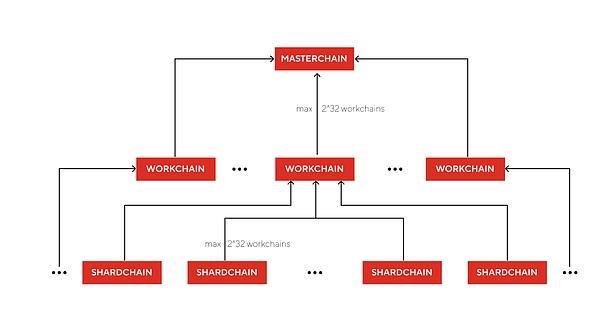
This multi-blockchain approach enables TON to efficiently handle various types and large numbers of transactions by delegating tasks to different chains according to its specialization.This division not only optimizes processing speed and network response time, but also enhances the network’s ability to dynamically scale based on load and demand.
Scalability through sharded chain
Scalability is a key aspect of the TON architecture, mainly implemented through its sharded chain.Each shard chain processes only a portion of the transaction, effectively dispersing the compute and storage workloads across the network.This approach reduces latency and increases throughput, as multiple sharded chains can run simultaneously without overloading any single chain.
The dynamic configuration of the shard chain also allows TON to adjust its scalability based on real-time usage and transaction volume.If a work chain is overloaded, it can be further subdivided into more sharded chains, thus distributing the load more evenly and maintaining high performance of the network
Cross-chain interoperability: Promote inter-chain communication
Interoperability within the TON is essential to maintain smooth communication between its various blockchain components.The main chain achieves this by managing cross-chain transactions and data transmissions, ensuring that operations across work chains and shard chains are consistent and secure.This system allows seamless interaction between different parts of the network, allowing complex operations involving multiple chains to be executed smoothly without user intervention.
Security: Proof of Stake and Nominee Pool
TON maintains its security through a Proof of Stake (PoS) mechanism, and verifiers protect the network by staking tokens.The PoS system is enhanced by introducing a pool of nominees, allowing smaller holders to collectively participate in the verification process, thereby democratizing the security process and enhancing the robustness of the network.Validators are motivated to remain honest due to participation in economic interests, while nominee pool ensures more holders can participate in cybersecurity.
TON’s multi-blockchain architecture, through the division of main chain, work chain and shard chain, is a powerful model for achieving the scalability, flexibility and security required by modern blockchain networks.This design allows TON to efficiently manage the growing ecosystem of decentralized applications and services while maintaining high throughput and strong security.
V. Economic and governance model
TON has experienced significant changes since passing a $1.7 billion ICO in 2019, but faces challenges due to regulatory hurdles.Revived by the TON Foundation in 2022, it has developed into a decentralized network with 5 billion tokens, with an annual growth of 0.6% (30 million tokens).Currently, 2.5 billion tokens are in circulation, supporting transactions, pledges and governance within the network.
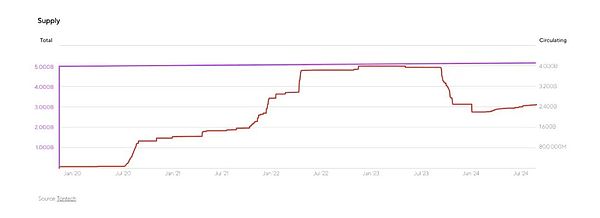
In the initial allocation, 98.55% of the tokens were mined through Proof of Work (PoW), and the remaining 1.45% was held by the development team.
In order to deal with centralized risks, a major proposal was passed in February 2023, freezing inactive wallets for four years, affecting 21% of the total supply.This decision targets 171 wallets holding more than 1.081 billion TON coins, accounting for about 21% of the total circulation.The move aims to enhance liquidity and sparked discussions on centralization and governance autonomy in the TON ecosystem, highlighting the delicate balance between regulatory action and decentralization principles.
Verifiers in the TON network play a crucial role in maintaining their integrity and if they perform their duties conscientiously, such as signing all blocks, staying online and avoiding invalid block signatures, they can earn up to 10 pledges per year.% of the profit.This reward system is enough to compensate validators, allowing them to invest in better hardware to manage growing transaction volumes.On average, it is expected that at any time, no more than 10% of the total supply of TON coins will be locked in the stake of the verifier, resulting in an annual inflation rate of about 2%.This inflation is seen as a community payment for validators to maintain network operations services.
Conversely, if validators behave badly, part or all of their pledges may be confiscated as punishment.A large portion of the confiscated pledge may be destroyed, creating a deflationary effect on the total supply of TON coins.A small percentage of fines may also be rewarded to validators or “fishers” who provide proof of malicious validator behavior, further enhancing the integrity of the network by incentivizing monitoring validator activities.
TON’s fee mechanism is significantly different from Ethereum’s user payment model.On the contrary, TON adopts a developer paid model.Unlike Ethereum’s synchronous smart contracts, both Dfinity and TON utilize asynchronous actor architecture to implement parallel computing.
The transaction fee of TON is composed of several parts: storage fee, message input and output fee, routing fee, and calculation fee.On average, the transaction fee is about 0.005 TON, but this value can be adjusted by the validator as needed.The purpose of transaction fees is to prevent malicious actors from overloading the network.In addition, half of the fees charged are used to reward validators and nominees, inspiring them to maintain the security and efficiency of the network.
Half of the transaction fees of TON are destroyed, meaning they are sent to a black hole address and removed permanently from circulation.In addition, most of the confiscated malicious validator funds will be destroyed.This destruction mechanism helps reduce circulation and supply, enhances the overall economic stability and deflationary characteristics of the TON network.TON can also be purchased directly through Telegram wallets for anonymous accounts, advertising and buying celebrities in the Fragment market.
Governance in the TON community
TON adopts a decentralized voting platform, TON.VOTE, where token holders can influence project development and major policy decisions.This participatory approach ensures a central position in the evolution of the ecosystem.
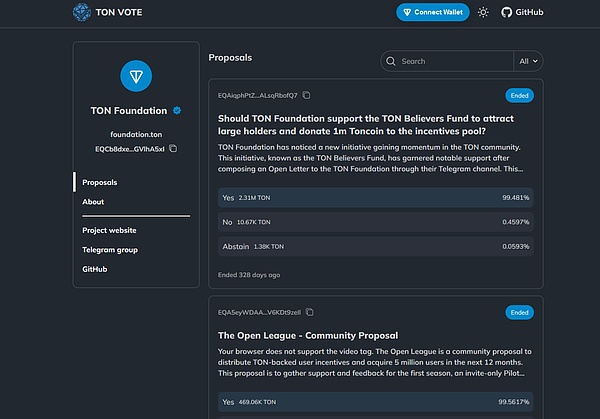
TON.vote Platform
Key investors and partners
TON’s institutional adoption has been significantly enhanced by significant investments from well-known companies such as Pantera Capital and Animoca Brands.Pantera Capital demonstrates high confidence in TON’s potential in the crypto market by launching a dedicated investment fund to raise capital to purchase TON tokens.Animoca Brands, known for driving games and opening up digital ownership in the metaverse, has become the largest validator on the TON blockchain, supports a variety of GameFi projects and integrates TON-based applications in Telegram.These strategic investments and partnerships highlight the strong institutional endorsement of TON capabilities and its future potential in the blockchain field.
Staking and its impact on decentralization
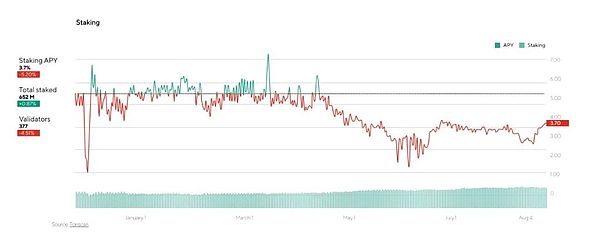
TON adopts a Proof of Stake (PoS) consensus model, where validators play a key role in maintaining network security, ensuring the effectiveness of blocks and receiving Toncoin as a reward.To participate, validators need advanced hardware and a large amount of Toncoin for fixed-term staking.High demands on hardware, such as 16-core CPUs and high-speed internet, often limiting this role to people with large resources, may focus control in the hands of wealthier participants.Not only do validators receive rewards from transaction fees and new coins generated during the verification process, with an average daily income of about 120 Toncoin, they also face severe penalties for not participating or malicious behavior, ranging from fines to complete confiscation of pledges.This structured incentive and punishment system is designed to ensure the health and integrity of the network.The competition for validator positions is fierce, and at least 300,000 Toncoin is required to enter the election. Successful candidates will verify the blocks throughout the verification cycle.
TON’s token economics is designed to balance validator incentives, ensure network security and maintain economic stability.The combination of the proof-of-stake consensus mechanism, a robust staking system and a transaction fee structure consistent with network usage ensures the sustainability and scalability of the TON blockchain.
6. The current situation of The Open Network (TON)
The Open Network shows measurable growth and activity, as can be seen from some financial metrics and user participation statistics.This section of the report provides an overview of TON’s current statistics highlighting key aspects of its ecosystem.
Total locked volume (TVL): TON’s TVL is about $919 million.Below we will discuss which apps have the most TVL.
Stable Coin: The stablecoin market capitalization on TON is US$619 million, and USDT is the only stablecoin available.TON accounts for about 0.38% of the total stablecoin market value.
The integration of USDT is particularly significant, especially in transactions conducted via Telegram.
Users can bridge USDT to the TON network through platforms such as Symbiasis and Layerswap, thereby promoting the use of stablecoins in the TON ecosystem.
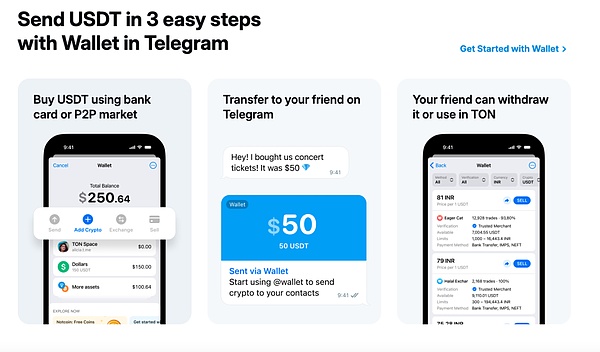
TON token indicator:
-
Current Price: $6.48
-
Market value: US$16.3 billion
-
Completely diluted valuation(FDV): $33 billion
User adoption
The user participation on the network is as follows:
-
Activate the wallet on the chain: More than 12 million on-chain wallets have been activated, a significant increase from about 1 million in January.
-
Monthly active wallet: The number of active wallets per month is 4.2 million, up from about 300,000 in January.
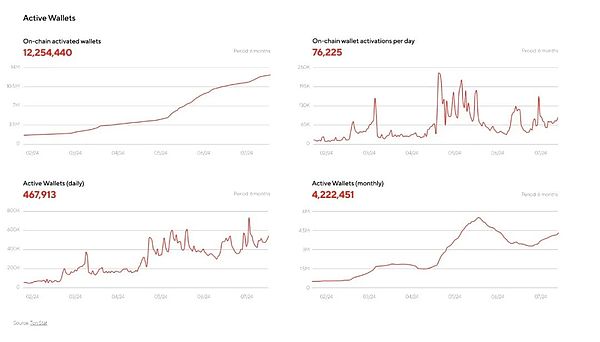
TON DEX Ecology: DeDust and STON.fi
The decentralized exchange (DEX) ecosystem on the TON blockchain features its innovation and user engagement, with seven operating DEXs making significant contributions to the ecosystem.In 2024, on-chain data showed a significant upward trend in transactions and daily active users, driven mainly by the Open League program and USDT native integration.Among these platforms, DeDust and STON.fi stand out for their significant trading volume and TVL.
Both DeDust and STON.fi have played a major role in TON’s recent growth in TVL, especially driven by Open League’s enhanced liquidity pool program.The program offers TON rewards to users participating in DeFi events, which significantly drives TVL growth, especially during the first four seasons of the program.For season 5, participants can explore enhanced pooling options on DeDust and STON.fi.
STON.fi
STON.fi is the highest TVL application in TON.It is well-known for its integration with TON wallets, simplifying the process of users directly exchanging tokens within the ecosystem, and it also allows users to become liquidity providers, with additional benefits to participating in staking and farm activities.The main statistics include:
-
TVL: Holding $277 million in TVL.
-
Strategic Development: STON.fi plans to develop into a cross-chain DEX, which will introduce functions such as order book and margin trading, significantly expanding its market appeal and functions.
DeDust
DeDust runs as an automated market maker (AMM) on TON and is the second most popular app on TVL on the Internet.It seamlessly integrates a variety of asset types, including local tokens and tokens from other blockchains.According to the latest data:
-
TVL: $258 million TVL.
-
Stake and SCALE tokens: It provides a staking plan that converts exchange fees into SCALE tokens for rewarding users.This not only promotes liquidity, but also stabilizes the ecosystem.
-
Trading efficiency: DeDust has been optimized for low gas fees and supports low-cost transactions.It supports stablecoin exchanges and complex transaction types such as multi-hop transactions.
-
Interoperability features: An early stage Ethereum bridging enhances the ability to manage packaging assets (such as WBTC and stablecoins) and to move assets across blockchain networks.

Comparison: DeDust vs. STON.fi
Swap.coffee: New DEX aggregator on TON
TON Blockchain recently welcomed a new member of its DeFi ecosystem, Swap.coffee, a DEX aggregator designed to enhance the user’s trading experience by providing the best exchange path.The platform stands out with its user-friendly interface, simplifying the trading process for users at all levels by automatically selecting DEXs and managing liquidity issues.
For experienced traders, Swap.coffee offers advanced settings that allow custom trading strategies, which, despite the high risk, offers significant savings for large trades.This feature is specifically designed for experienced users who are looking for more control and higher profit margins.
Use Tonstakers for mobile staking on TON
Tonstakers is TVL’s third-ranked project with $212 million in management.
Tonstakers has introduced a dynamic liquid staking method in the TON blockchain, providing users with opportunities to gain profits under safe, equal and transparent conditions.The service is tailored to users who want to contribute to blockchain security and receive rewards without sacrificing access to their pledged assets.
Safe and open mobile pledge
Tonstakers work with TON core developers to ensure the platform is robust and well integrated in the TON ecosystem.It is centered on transparency and security, and its open source protocol can be reviewed and contributed on GitHub.In addition, the platform’s security measures have been audited by Certik, a leading blockchain security company, ensuring that they are secure at the core.
Non-custodial pledge
A prominent feature of Tonstakers is its unmanaged staking approach.Users maintain full control over their assets without any intermediaries, which means that although their TON coins are pledged, they are not held or controlled by Tonstakers, but are always at the hands of the users.
Telegram Advertising: Use TON for effective marketing
One of the major advantages of TON’s collaboration with Telegram is its ability to attract a Web2 talent pool.This appeal is mainly attributed to the familiar marketing and channel acquisition tools integrated into the Telegram platform.
Telegram Ads allow items to purchase ads displayed at the bottom of the Telegram channel.This feature has proven to be a very effective component of the listing strategy of many Web3 startups operating on Telegram.These ads not only help to expand the reach and visibility of the project, but also promote direct interaction with the target user base.
A key aspect of Telegram advertising is its payment structure.Advertising is purchased with TON. It is worth noting that 50% of advertising revenue will be distributed to channel owners in the form of TON.This revenue sharing model motivates channel owners to actively participate in the advertising network, enhancing the overall growth and engagement of the ecosystem.
Advertising can be purchased at https://ads.telegram.org/ or https://fragment.com/ads.
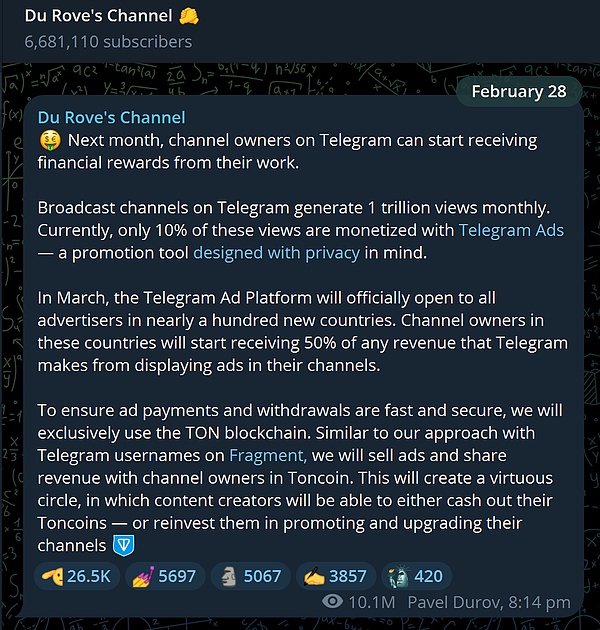
TON’s growth adoption in Asia
Interact and trade with Telegram Mini Apps
Hamster Kombat is a click-and-earning game in which players play the role of CEO of cryptocurrency exchanges.By clicking on the hamster on the screen, players can accumulate game points and receive rewards in a variety of ways.The game combines a simple click mechanism, passive revenue mining function and card system to enhance its depth and entertainment.According to the official Twitter account, as of June 24, 200 million “hamsters” have participated!
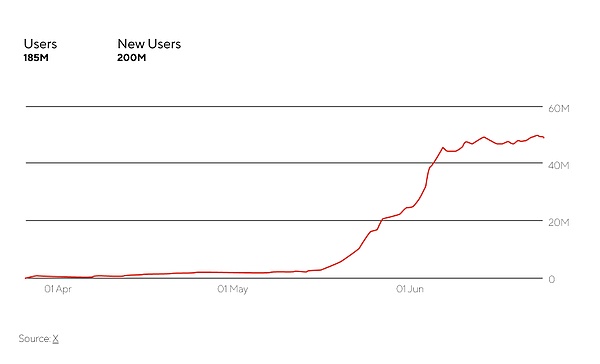
In Tehran, Iran, taxi drivers, cyclists and pedestrians are all crazily clicking on their phone screen under the hot June traffic lights.Their goal is an app called “Hamster Kombat” which they believe will make them rich.
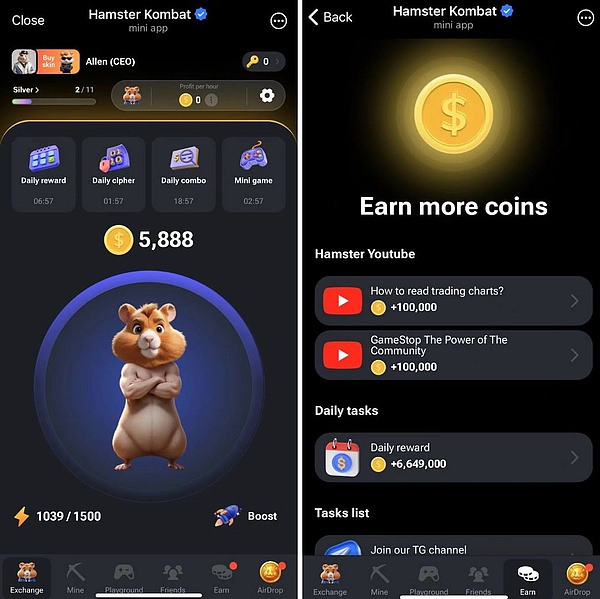
Iran’s Hamster Kombat boom is similar to Axie Infinity’s success in Southeast Asia.During the Philippines’ high unemployment rate, Axie Infinity players earned more than $300 per month by playing the game.
Hamster Kombat is more than just a game; it is clearly driving massive adoption of Web3 and promoting community building.
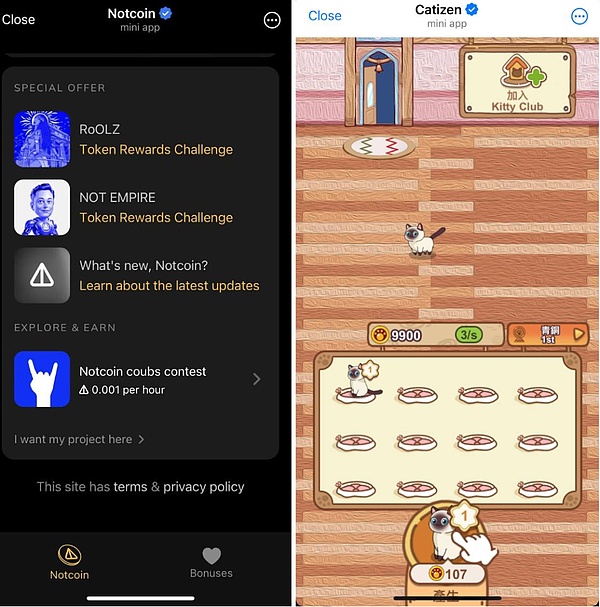
(Notcoin VS Catizen)
Integrate with Bitget to enhance transaction convenience
Bitget quickly integrates the Telegram mini app, providing features such as direct spot trading within Telegram.This integration allows users to easily trade cryptocurrencies without switching between different applications.In regions dominated by mobile-first strategies, the ease of combining social context with cryptocurrency transactions may significantly enhance user adoption and market penetration.
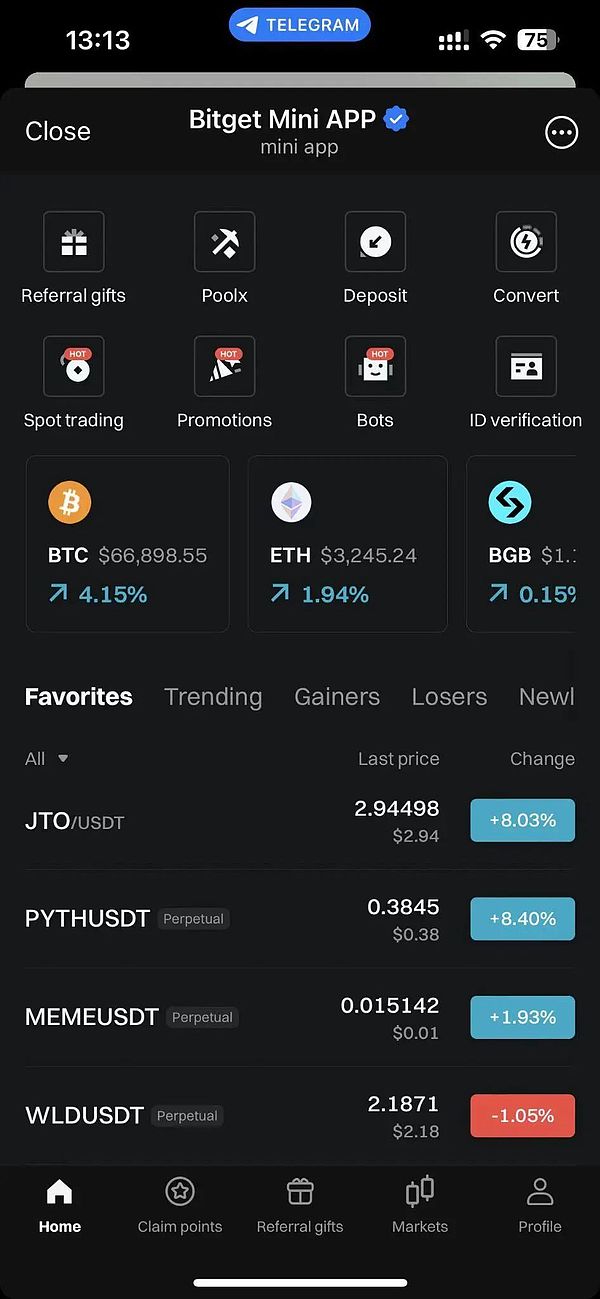
Bitget Telegram applet
Game Development and GameFi on TON
Asian Game Studios dominates mobile games and will become a huge force on TON.
In addition, Hong Kong-based Animoca Brands, as a key player in the GameFi field, has become the largest validator on the TON blockchain.This position highlights the importance of TON in supporting third-party games and GameFi projects.The TON Play platform provides developers with tools to port existing online games directly to Telegram, leverage its huge user base and promote new forms of interaction through decentralized games.
Web3 Development Plan
The TON Foundation works with Tencent Cloud and Chainbase to simplify the development process and enhance developers’ deployment capabilities, and further promote the adoption of Web3 technology.By providing the necessary tools and resources, this program is designed to make it easier for developers to create and publish applications on the TON blockchain.
Recognition and adoption in the UAE
The United Arab Emirates (UAE), especially the Dubai International Financial Centre (DIFC), has officially recognized the TON blockchain, along with major cryptocurrencies such as Bitcoin and Ethereum.This recognition allows financial institutions in Dubai to trade using Toncoin, demonstrating TON’s growing acceptance and institutional trust in important financial markets.Official recognition not only enhances TON’s credibility, but also opens up numerous possibilities for its use in the region’s financial transactions and regulatory framework.
India
India has the second largest smartphone user in the world, providing significant smartphone popularity potential.In 2016, the launch of Reliance Jio completely changed the telecom industry, resulting in a significant increase in data consumption through data pricing that is significantly lower than the market price, jumping from an average of 400MB per user per month to 11GB.Currently, while the average price of 1GB data worldwide is $5.09, in India, the price is only $0.09.
This creates an ideal environment for Telegram and its ecosystem.With over 100 million downloads in India, Telegram is one of the most popular messaging apps.Integrating these users into the TON ecosystem provides a unique opportunity to monetize this huge user base.
As Web3 becomes increasingly mainstream, more applications will prioritize mobile-first UI/UX designs to meet the vast market for smartphone users similar to the Telegram Mini application model.India will be a key region in future consumer application development and user growth.
7. Future prospects
The TON strategy is positioned to unlock numerous opportunities for monetization, sharing and growing businesses for the Telegram community.A prominent example is the decentralized market Fragment on the TON network, where users can trade virtual phone numbers and custom Telegram usernames.Fragment has contributed to more than $350 million in sales so far, demonstrating the platform’s potential.A promising development that is coming is to convert Telegram stickers to NFTs, which may significantly enhance engagement and revenue.Given that 730 billion stickers have been sent, providing them as NFTs on the TON blockchain presents a huge opportunity.
Telegram is integrating revenue sharing for content creators and channel owners through its Fragment platform, leveraging the TON blockchain to gradually transform its revenue model.This shift from traditional social media models allows creators to profit directly from advertising revenue on their channels, promoting a more equitable distribution of financial benefits in the digital ecosystem.This method not only rewards creators’ content, but also strengthens the relationship between the platform and users.In addition, the air-free fee transfer features provided by built-in upper and lower chain channels, including bank transfers and exchanges, enhance accessibility and availability, especially for users in developing countries who lack banking services.
Telegram has become the first chat app to seriously get involved in the gaming world.Since integrating HTML5 compatibility for Telegram robots in 2016, the development of TON blockchain is aimed at further reducing friction between users and developers.Through TON, developers can access payment channels, decentralized storage for in-game assets, and smart contracts for secure and automated game mechanics, allowing them to effectively distribute their content to a 900 million monthly active userCommunity.
TON has differentiated itself from platforms such as WeChat and other Western social applications by establishing Telegram as the main portal for the transition from Web2 users to Web3.With approximately 900 million MAU, Telegram represents one of the largest pools of “Web2.5 users” and becomes the main distribution channel in the main crypto market.Unlike centralized exchanges such as Coinbase and Binance, Telegram’s social nature makes it more suitable for applications that combine social functions with financial incentives, providing a better product market fit for gaming and other interactive experiences.
Distribution is the key to TON’s recent success, highlighting the challenges faced by Web3 game developers in acquiring players.Growth programs, including funding, technical support and marketing assistance, accelerate teams’ pace into the ecosystem.In the short term, many teams may use TON’s current thinking influence to attract users to their game or protocol.As developer tools and support become more mature, games that adopt a WeChat-like platform-like lesson and adapt in a Telegram-based native way will be an important case study.
Looking ahead, TON has a bright future, with great potential in monetization, stablecoin integration, and the thriving ecosystem of mini apps and games.By leveraging its huge user base, scalable infrastructure and innovative revenue models, TON is expected to be a leading force in the blockchain space, driving significant advances in decentralized finance and digital content creation.








